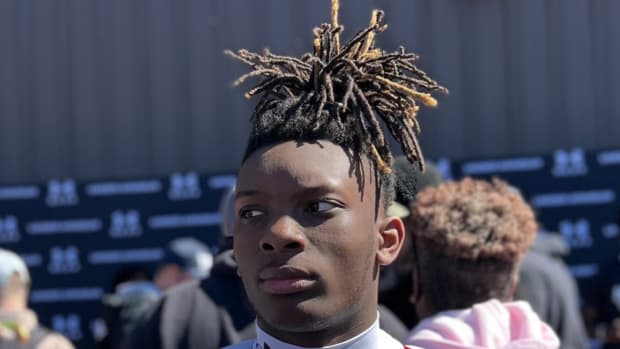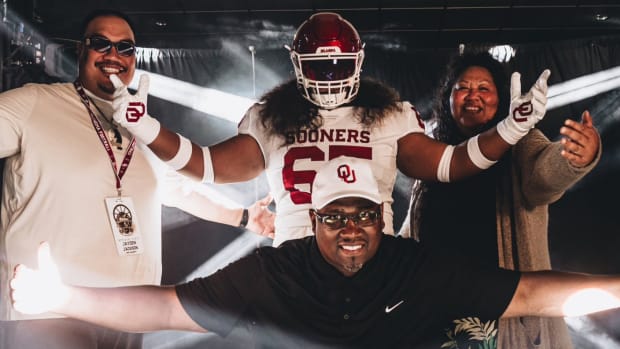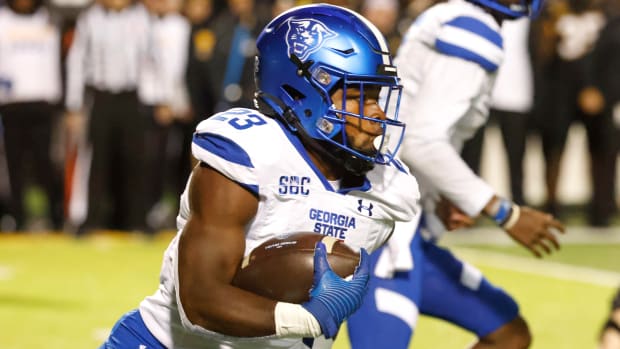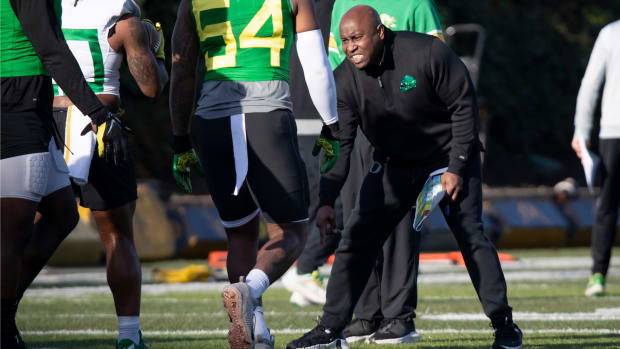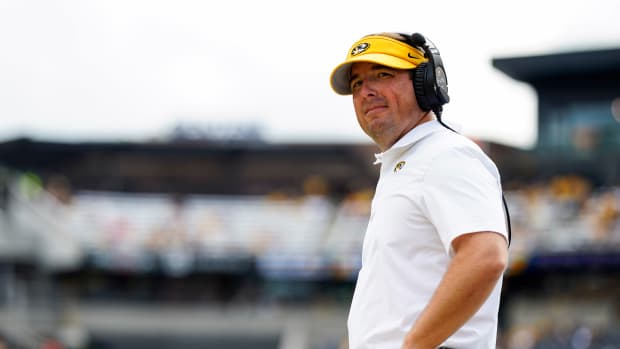How West Virginia Is Preparing Its Stars for the Biggest Year of Their Lives
ATLANTA — Eighteen eyes grow wide when Trent Baalke mentions tattoos. Not all of the nine West Virginia players assembled around a meeting room table in a midtown hotel have tattoos, but all of them shake their heads and exchange bewildered glances as Baalke, the former San Francisco 49ers general manager, explains that nearly every NFL team will examine every tattoo they have. Teams will compare the players’ ink against examples of tattoos that reveal gang affiliation or other potential red flags.
You have reached your limit of 4 premium articles
Register your email to get 1 more
The players, all of whom hope to go through the NFL draft process next year, knew the process would be intense, but as Baalke keeps talking, they begin to grasp just how intense the process will be.
“Every weakness you have is going to get exposed,” Baalke says.
In the back of the room, Dana Holgorsen and Alex Hammond nod. This reaction is exactly why they planned this weekend excursion with their best players.
This is the most talented team Holgorsen has had since he took over in 2011 as West Virginia’s head coach. Alabama or Clemson or Ohio State may deal with this every year, but most college football programs don’t routinely have this many veteran players with shots at the NFL. That’s why Hammond, West Virginia’s associate athletic director for football, approached Holgorsen earlier this year with an idea. Having this many good fourth- and fifth-year players means West Virginia might have a special season, but those players will be subject to some unique stressors during the next year. Other college students attend professional development seminars to help prepare them to enter the workforce in their chosen fields. Why not create a such a seminar for aspiring professional football players?
So Hammond and Holgorsen designed a curriculum. They would put their players in front of experts who could offer advice on how to best handle a year of their lives that—if handled correctly—could pay dividends for generations or—if handled incorrectly—could be a golden opportunity squandered. They would address big-picture issues such as the draft process, what agents do and how they recruit, leadership and financial planning. They also would address less obvious ones such as dressing for success and learning how to travel like a professional.
That’s how quarterback Will Grier, linebacker David Long and seven of their teammates wound up in Atlanta five days before this year’s draft learning how NFL teams will comb through their lives prior to next year’s draft.
The lessons begin before the players leave Morgantown. Hammond and Holgorsen take them to Daniel’s, a 55-year-old men’s clothing store a few miles from campus. There, they learn from owner Phil Mauser how a suit should fit (trim, but not tight). They learn basics (match belt and shoe color) and discuss more advanced issues (how much shirt cuff should be visible past the jacket sleeve). A tailor takes each player’s measurements, and each player chooses a sport coat, a pair of slacks and a shirt that will be tailored to his specifications before the group leaves for Atlanta. Why would West Virginia need to buy these players dress clothes? Because they’ll be representing the school at Big 12 media days or on the awards show circuit after this season. And if tight end Trevon Wesco winds up answering reporters’ questions in July or collecting an award in December, he’s going to look resplendent in a cornflower blue jacket and khaki slacks.
This particular piece was important to Holgorsen because a former player came to the coach a while back and admitted to being embarrassed upon arrival at Big 12 media days. Players from other schools had come dressed to the nines, and this player wore a T-shirt and sandals as he arrived with his teammates to check in at a high-end hotel. Holgorsen, who had to teach himself to move in professional circles as he came up through the coaching business, realized that something as simple as a proper fitting sport coat and pants could make a difference in how others perceived his players and how those players perceived themselves.
Before we go any further, let’s answer some questions that have almost certainly popped up as you’ve read about a school buying dress clothes for players and flying them to another city for a seminar. How is West Virginia allowed to do this? First, NCAA rules allow schools to outfit players who may have to represent the program at events such as conference media days or football awards shows. Second, the NCAA actually encourages schools to provide professional development services for their athletes. This is bylaw 16.3.1.1 (emphasis added): “Member institutions shall make general academic counseling and tutoring services available to all student-athletes. Such counseling and tutoring services may be provided by the department of athletics or the institution’s nonathletics student support services. In addition, an institution, conference or the NCAA may finance other academic support, career counseling or personal development services that support the success of student-athletes.” West Virginia has a compliance department to interpret these rules, but it also helps that before Hammond came to Morgantown to work with Holgorsen, he worked in the NCAA’s enforcement department investigating basketball eligibility cases. He has spent plenty of time with the NCAA manual.
While the attire and travel lessons can help the players regardless of whether they play in the NFL or not, most of the other discussions were more specific. Shortly after the group arrives in Atlanta, Holgorsen asks the players if they would like to tweak any aspect of West Virginia’s practice schedule. Do they like the spiders (the soft foam shoulder pads players wear during non-contact practices) that they’ve been using? Do they meet too much at the hotel before away games? Grier, the Florida transfer who threw for 3,490 yards and 34 touchdowns in an injury-shortened first season on the field at West Virginia, asks if the time of the Mountaineer Mantrip—the team’s walk through the fans before home games is named after the method by which coal workers descend into the mines—is set in stone at two hours and 15 minutes before kickoff. He’d like a little more time to prepare once the team arrives at Milan Puskar Stadium. The players then discuss the logistics of a change to this time relative to wake-up calls for noon kickoffs. Holgorsen reminds the players that the coaching staff has no control over kickoff times. The Big 12’s television partners decide those. Grier then reminds his teammates that there is usually one sure way to minimize noon kickoffs. “We need to win more,” Grier says.
Holgorsen also discusses messaging. This group includes eight seniors and a fourth-year junior (Long). He probably wouldn’t have planned this trip had West Virginia’s best players not also been the oldest players. “These nine guys will all be graduated by the time they give me a hug on Senior Night,” he says. Holgorsen realizes receiver Gary Jennings or offensive tackle Yodny Cajuste might reach a younger player when he can’t. So he asks the veterans to help the coaching staff establish a tone throughout this offseason and into preseason camp. It is time, he says, for West Virginia to take the next logical step as a Big 12 member, and this is the group that can take that step. “We should be pissed off at average,” Holgorsen says.
After establishing the players’ responsibility to this team, the program moves on to what the players can do to best prepare themselves for the next step of their lives.
During a discussion about agents, players sheepishly raise their hands when asked if they had been contacted by agents hoping to represent them. Hammond interjects, reminding the players that it isn’t against NCAA rules for players to talk to agents. (But the players should ask any agent who makes contact if that agent is registered with the state of West Virginia.) It’s against the rules to take money from them or enter into an agreement with them, but the players will need to interview prospective agents before deciding who will represent them beginning in January. But Hammond also points out that players should not let the agent selection process become a distraction from the football season. The bye week could be a time to handle some of that business.
Players furiously write notes to themselves as Baalke explains the pre-draft process. With 20 years of experience on the personnel side as a scout or as an executive, Baalke knows the methods NFL teams will use to assess a player’s personality. He asks safety Dravon Askew-Henry to go to the white board at the front of the room and draw his favorite coverage. As Askew-Henry aligns the defense on the board, Baalke shifts gears.
Tell me about your family.
Have you ever been in trouble?
Then he shifts back to football. This serves two purposes. He wants to see if Askew-Henry knows the scheme well enough to explain it correctly while distracted by non-football questions. He also wants to surprise Askew-Henry with questions he didn’t think he’d get when he walked to the white board. This might draw a more revealing response.
As Baalke explains the pre-draft interviews—which often are more important than any on-field drill—he advises the players to be brutally honest with teams. Players fall down draft boards or get dropped entirely when they lie or fudge the truth. “The person asking the question,” Baalke says, “probably already knows the answer.”
Later, former West Virginia defensive lineman Patrick Marlatt explains his business to the players. Marlatt, who played for the Mountaineers from 1985 to ’88, is a vice president at Captrust Advisors, a wealth management firm in Raleigh, N.C. With Marlatt is Taylor Nowell, a wealth management advisor whose clientele includes NFL players. Hammond wanted the players to learn about financial advisors for several reasons. Aspiring financial advisors can get players and schools in trouble—Reggie Bush and USC, for example—and choosing the wrong financial advisor can leave a former NFL player broke even if he made millions over the course of his career.
Marlatt and Nowell begin with the basics. Nearly every player’s pen hits paper when the financial advisors point out exactly how much of a player’s salary will be wiped out by taxes. The players learn that after Uncle Sam takes his cut, this figure can go up or down based on state taxes. Suddenly, the players start hoping to wind up with the Buccaneers, Cowboys or Titans (which are in states without a state income tax) instead of the Rams (California takes 13.3% for a single person making more than $1 million a year).
The other number Marlatt and Nowell use a lot is 3.2. That’s the average number of years in an NFL career. Given that, they advise an extremely conservative budget that probably doesn’t sound like much fun to 22-year-olds on the verge of making six- and seven-figure salaries. Even for the player selected fourth overall in the draft—who can expect to make $29.5 million over four years—Marlatt and Nowell advise living only on a little more than $300,000 a year. That way, the player can sock away more than $16 million over four years. If he washes out of the league, he can live comfortably the rest of his life. The player drafted 256th overall, meanwhile, should try to live on a little more than $150,000 a year. If he makes the $2.5 million average for a four-year career, he could put away more than $684,000. When he enters the non-football workforce, that player would be miles ahead of most 26-year-olds.
Marlatt doesn’t only advise against spending extravagantly. He also advises against investing extravagantly. NFL players get bombarded with potential deals, but while they’re still earning, they’re better off investing in medium-risk funds that grow at about the same rate as the economy in general. “When you play football, don’t worry about buying Smoothie Kings or car washes,” Marlatt tells the players. “Just play football.”
The trick, the advisors say, is learning to say no and accepting the fact that even a player who has millions guaranteed will go broke if he tries to take care of every family member and friend. The advisors also warn the players against allowing their agent to help select their financial advisor. In fact, they suggest players chosen high in the draft hire an agent, a financial advisor, an attorney and an accountant entirely separate from one another. That way, each can serve as a check and balance against the others. Handing all those responsibilities to one person or one organization is the easiest way to get swindled.
Receiver David Sills V, who tied in 2017 for first in the nation in touchdown catches (18) in his first full season at the position, asks how long a player must stick in the NFL to qualify for a pension (three years). Sills also asks whether it’s wiser to rent or buy a residence given the fact that a player may wind up on another team in a year. (Nowell’s advice? Buy where you’d like to live long-term and rent a place in your current NFL town.) Meanwhile, defensive end Zeke Rose instantly becomes the favorite of the advisors during a discussion about what a relatively poor investment a luxury car is. “Nothing wrong with a Honda,” says Rose, who grew up in Clarksdale, Miss., and appeared on Last Chance U while playing at East Mississippi Community College.
Holgorsen and Hammond hope the players heed the advice they got during the seminar. If they succeed long-term, that will only help Holgorsen recruit similarly talented players for his team. He’d like to repeat this exercise annually, but he’ll only do it if he has a leadership group as mature as this one.
As the players make their way through the Pittsburgh airport dressed in their jackets and slacks, heads turn as they pass. “Who are those guys?” someone asks Hammond. “Are they NFL players?”
Not yet. But they should be soon. And now they’ll be armed with a little more knowledge before they get there.

